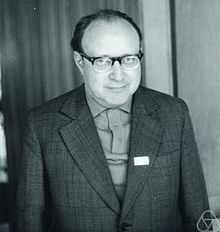Eugene Dynkin
Eugene Dynkin | |
|---|---|
Eugene Borisovich Dynkin (Russian: Евгений Борисович Дынкин; 11 May 1924 – 14 November 2014) was a
Biography
Dynkin was born into a
Moscow University
At the age of 16, in 1940, Dynkin was admitted to
USSR Academy of Sciences
In 1968, Dynkin was forced to transfer from the Moscow University to the
Cornell
He remained at the Institute until 1976, when he emigrated to the United States.[1] In 1977, he became a professor at Cornell University.[1][4]
Death
Dynkin died at the Cayuga Medical Center in Ithaca, New York, aged 90.[5][6] Dynkin was an atheist.[7]
Mathematical work

Dynkin is considered to be a rare example of a mathematician who made fundamental contributions to two very distinct areas of mathematics:
Lie Theory
While Dynkin was a student at Moscow University, he attended Israel Gelfand's seminar on Lie groups. In 1944, Gelfand asked him to prepare a survey on the structure and classification of semisimple Lie groups, based on the papers by Hermann Weyl and Bartel Leendert van der Waerden. Dynkin found the papers difficult to read, and in an attempt to better understand the results, he invented the notion of a "simple root" in a root system. He represented the pairwise angles between these simple roots in the form of a Dynkin diagram. In this way he obtained a cleaner exposition of the classification of complex semisimple Lie algebras.[10] Of Dynkin's 1947 paper "Structure of semisimple Lie algebras", Bertram Kostant wrote:
In this paper, using only elementary mathematics, and starting with almost nothing, Dynkin, brilliantly and elegantly developed the structure and machinery of semisimple Lie algebras. What he accomplished in this paper was to take a hitherto esoteric subject, and to make it into beautiful and powerful mathematics.
— Bertram Kostant, "Selected papers", p. 363
Dynkin's 1952 influential paper "Semisimple subalgebras of semisimple Lie algebras", contained large tables and lists, and studied the subalgebras of the exceptional Lie algebras.
Probability theory
Dynkin is considered one of the founders of the modern theory of
Dynkin's one-hour talk at the 1962 International Congress of Mathematicians in Stockholm, was delivered by Kolmogorov, since prior to his emigration, Dynkin was never permitted to travel to the West.[11] This talk was titled "Markov processes and problems in analysis".
Prizes and awards
- Prize of the Moscow Mathematical Society, 1951
- Institute of Mathematical Statistics, Fellow, 1962
- American Academy of Arts and Sciences, Fellow, 1978
- National Academy of Sciences of the USA, Member, 1985[12]
- American Mathematical Society, Leroy P. Steele Prize for Total Mathematical Work, 1993
- Moscow Mathematical Society, Honorary Member, 1995
- Doctor Honoris Causa of the Pierre and Marie Curie University (Paris 6), 1997
- Doctor of Science (honoris causa) of the University of Warwick, 2003.[13]
- Doctor Honoris Causa of the Independent Moscow University (Russia), 2003
- Fellow of the American Mathematical Society, 2012[14]
Publications
- Theory of Markov Processes. Prentice-Hall. 1961.[15]
- Die Grundlagen der Theorie der Markoffschen Prozesse. Grundlehren der mathematischen Wissenschaften, Band 108. Springer Verlag. 1961.[15]
- Markov Processes. Grundlehren der mathematischen Wissenschaften. Springer Verlag. 1965.
- Controlled Markov Processes. Grundlehren der mathematischen Wissenschaften. Springer Verlag. 1979.
- Markov Processes and Related Problems of Analysis, Selected Papers. London Math. Soc. Lecture Notes Series, 54. Cambridge University Press. 1982.
- Dynkin, Eugene B. (2000). Yushkevich, A. A.; MR 1757976.
- Diffusions, Superdiffusions and Partial Differential Equations. AMS Colloquium Publications. 2002.[16]
- Superdiffusions and Positive Solutions of Nonlinear Partial Differential Equations. American Mathematical Society. 2004.
See also
- Algebra
- Affine Dynkin diagram
- Coxeter–Dynkin diagram
- Dynkin index
- Dynkin–Specht–Wever Lemma
- Probability
- Dynkin's card trick
- Dynkin's formula
- Dynkin system
Notes
- ^ S2CID 250835688.
- ^ O'Connor, John J.; Robertson, Edmund F., "Eugene Borisovich Dynkin", MacTutor History of Mathematics Archive, University of St Andrews
- ^ a b c Dynkin (2000, p. xiii)
- ^ In Dynkin (2000, p. xv), Dynkin states "I came to the United States from the Soviet Union in 1977".
- ^ Евгений Борисович Дынкин (in Russian). Moscow Mathematical Center of Continuous Education. Retrieved 16 November 2014.
- ^ Cornell Chronicle obit
- ^ "Conversation of Eugene Dynkin with Sergei Kuznetsov, Ithaca, New York, July 25, 1999" (PDF).
- ^ Dynkin (2000, p. xi)
- ^ a b Dynkin (2000, p. 385)
- ^ Dynkin (2000, p. xiii,7)
- ^ Dynkin (2000, p. 388)
- ^ "Eugene Dynkin". NAS.
- ^ "News in 2003". Warwick Mathematics Institute. Retrieved 19 August 2015.
- ^ List of Fellows of the American Mathematical Society, retrieved 2012-11-10.
- ^ .
- .
External links
- Eugene Dynkin at the Mathematics Genealogy Project
- O'Connor, John J.; Robertson, Edmund F., "Eugene Dynkin", MacTutor History of Mathematics Archive, University of St Andrews
- Department listing at Cornell University
- Personal web page
- Genealogy Tree of Dynkin's School
- Collection of interviews assembled by Dynkin
